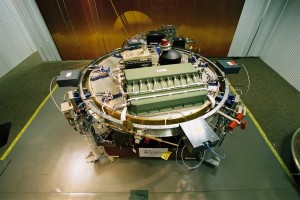ESOC radio engineer Boris Smeds has become a modest celebrity for his single-handed discovery of a fatal design flaw in Huygens’ radio relay link; one magazine credibly dubbed him a “hero.” But developing the mission recovery plan required a team effort involving hundreds.
Editor’s note: Repost of an article published in January 2005. Today marks the 8th anniversary of the landing of ESA’s Huygens – delivered by NASA’s Cassini – on Titan. The touchdown remains today the farthest landing ever made by a human artefact.

The Huygens engineering model located at ESOC, Darmstadt, Germany. The EM was used extensively to confirm the presence of a communications problem between Huygens and Cassini. Credir: ESA
Media interest in the little-known story of how the Huygens mission was recovered from near-certain disaster started to grow last fall as the joint NASA/ESA/ASI Cassini-Huygens mission neared its 14 January 2005 rendezvous with Titan.
The news media and pundits generally got the story correct: that Boris Smeds, Head of the Systems and Requirements Section at the European Space Agency’s Space Operations Centre (ESOC) in Darmstadt, Germany, had found and confirmed a telecommunications flaw encoded into radio receiver software onboard Cassini.
Smeds was able to confirm the existence of the flaw only after pushing through an extensive series of tests that was initially rejected by mission managers as unnecessary.
Smeds confirmed the existence of the fatal software flaw in the Probe Support Avionics (PSA), mounted onboard Cassini, in a series of tests conducted in February 2000.
Details on the 8th anniversary of the epoch-making Cassini-Huygens mission, including video on The Huygens Experience, via ESA Science.


Discussion: no comments